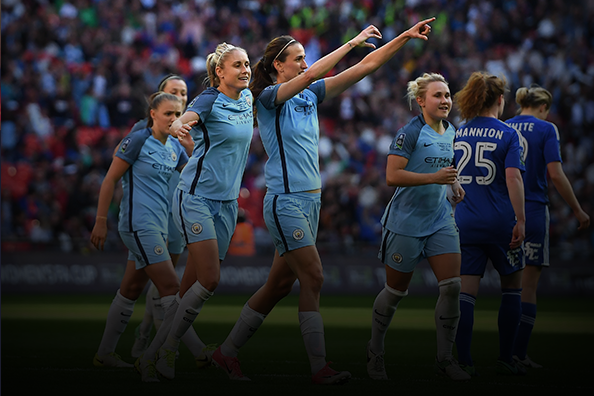Oliver McManus has a look at the rise of women’s football and why the naysayers should give it a chance.
Women’s football is a sport on the up, captivating new audiences and producing the next generation of young talent – why has the game became such a success and what does the future hold?
Recently, the Spring Series kicked off to mark a transitional period for the Women’s game; a move away from the MLS-esque summer-only league to, the traditional, full Autumn-Winter-Spring season.
This step is symbolic of the progress England has made in the female football department – from a sport which was hidden deep into the depths of the channel guide in, say, 2007 to one where broadcasters are falling over themselves in a bid to bring England’s brightest talents to their screens – 3 channels currently show the game, BT Sport screen live games of the WSL, BBC air Cup Matches and Weekly highlights and Channel 4 will air the European Championships later this year.
So, what has driven this increase in quality of the women’s game?
Well, a whole host of factors really – none less than the introduction of England’s first ever professional women’s football league. Known as the Women’s Super League, it was meant to get underway in 2010 but the start was setback a year due to global economic problems.

For the first season, 16 teams applied for licenses to compete; Arsenal, Barnet, Birmingham City, Bristol Academy, Chelsea, Colchester United, Doncaster Rovers Belles, Everton, Leeds Carnegie, Leicester City, Lincoln Ladies, Liverpool, Millwall Lionesses, Newcastle United, Nottingham Forest and Sunderland.
Clearly then, there was interest from the clubs to make this a success but the public were still to be won around. To be fair, attendance wise, it was a real mixed bag with an average of 584, highs of 2,510 and lows of 120.
On the field, Arsenal led the way as they won the inaugural season by just 3 points, Birmingham closely followed them in a league which saw an average of 2.54 goals a game – both a demonstration of the attacking football played as well as the varying degrees of quality.
If we fast forward a mere 6 years to today, crows average around the 1,100 mark and Manchester City are leading the way with regular attendances of 2,253 – City are now targeting 3,000 for the new full season.
And there is good reason for this surge in popularity – the WSL has, very cleverly, marketed itself as an affordable day out for the family. Tickets to a match cost between £2 and £8 – compared to upwards of £60 in the Premier League – by doing this, they enable a whole new audience to be able to attend football games on a regular basis.
Let’s be real, it’s not financially viable for your average working class family to splash out £200 for a family trip to the footy but when there’s the option of watching a top-quality game for £8 then, hey-ho, let’s have some fun!
Such has been the exponential development in quality of the WSL, that the FA has expanded the competition from an 8-team league in 2011 to, now, a 20-team, 2 division system with active promotion and relegation.
Further to that, clubs have been able to attract the best players from around the world with a bolstering to their finances.
Let me give you a personal example;
My cousin, Amy, used to play for Gillingham and Charlton Ladies – a genuinely top-class player, I remember watching her in a match just a stone’s throw away from my house. When she was 17, though, she quit the game for good.
Why? Well she found a weekend job earning £3-something an hour and she decided to go with this. Now, these days, that wouldn’t even be a consideration – Steph Houghton, the England captain, is the highest earning player in the WSL and takes home £66,000 a year.

Steph Houghton and Jordan Nobbs of England pose alongside the Sir Bobby Moore statue outside Wembley. (Photo by Bryn Lennon/Getty Images)
Having said that, we in England haven’t got the best monetary model in history – players in America can earn up to £3.9million a year (albeit mainly through sponsorship).
Recently, it was announced that Notts County Ladies were to fold just 2 days before the start of the WSL Spring Series – documents revealed that they had a projected income around the £35,000 area but outgoings of upwards of £500,000. Certainly, then, progress has been made within the WSL but it is by no means a polished product.
The next factor in the drive of popularity of the women’s game is, put simply, the incredible form of the Lionesses. Whereas previously, the women’s team could be considered as stale under-achievers, the last 4 years have been a symbol of triumph for Mark Sampson’s team. Sampson replaced Hope Powell in August of 2013 after Powell had previously spent 15 years at the helm.
Powell is, undoubtedly, an icon of the English game but during the latter years of her tenure, things started to get prickly; the 2011 World Cup saw an unceremonious exit at the hands of France, with Powell branding those who didn’t volunteer to take a penalty as “cowards”.
Two years later came the nail in the coffin for Hope Powell – England, the 4th seeds, disastrously crashed out of the UEFA Women’s Euros, finishing bottom of their group containing France, Russia and Spain. England out, Powell out.
In came, a young, Mark Sampson – a man with proven pedigree. Impressive at Taff’s Well, he earned a crack at Bristol Academy and, despite tough times, led them to the highest WSL finish in their history (runners up, achieved in 2013).
The first challenge of his reign was qualification for the 2015 FIFA Women’s World Cup; a challenge easily conquered. Sampson had rejuvenated the team by bringing a mixture of young talent, Toni Duggan & Fran Kirby to name just two, with experienced campaigners such as Rachel Yankey and Fara Williams.
This fresh new mix created a whole different type of energy within the squad, their style was free-flowing and attacking and the end result was potent. What they had in attack, they had at the back too – enough quality goalkeepers to warrant rotation through choice and a back-line tighter than my wallet!
What I’m trying to say is, Mark Sampson took a team which was relatively dead-in-the-water and forced it to the forefront of public attention – 52 goals from 10 matches is hard to ignore and, well, we didn’t. 8,908 people turned out to watch their 9-0 thrashing of Montenegro – a 60% increase from their peak figure of the previous campaign.

Mark Sampson celebrates the win over the United States during the SheBelieves Cup at Red Bull Arena. England defeated the USA 1-0. (Photo by Elsa/Getty Images)
When the team went to Canada they carried the hopes of a nation – not least because the men’s national team has been a disgrace for the last 10, 15 years – and they went out there with a real desire to leave a mark on the world stage.
And make a mark they did – bouncing back from a 1-0 loss in their opening game, they quickly followed up with two successive 2-1 victories to ensure progression to the Round of 16.
Despite going a goal behind, 2 goals in 15 minutes set up a quarter-final clash with Canada – the biggest game in the Lionesses history. Would they buckle under the pressure? NOPE, a fast-flying start put them 2 up after just 14 minutes, enabling them to withstand a late Canadian barrage.
Then came heartbreak. A moment that will be etched into history. THAT own goal by Laura Bassett. It’s 1-1, 1 minute to go until extra time. The ball comes in the box, Bassett sticks a leg out. It’s sailing towards the net, everything is going in slow motion, surely it won’t go in? The ball clips the bar and lands the wrong side of the line, cue devastation.
A mere 3 days later though, they dusted themselves up and put in a champions display to, firstly, take deadliest rivals Germany into extra time before Fara Williams slotted home a 108th minute penalty to secure England an historic 3rd place – making them the most successful British team since 1966.
A feel good factor? Certainly. A whole new aura of optimism swept the nation because, suddenly, this was the team to watch, a team that are on the verge of greatness. Inconspicuous returns home were a thing of the past and their arrival home was met with flock upon flock of fans at the airport.
For this squad who had left, albeit in the public domain but, with a set following, they suddenly found themselves talked on the front page of the biggest newspapers and at fever-pitch.
What does the future hold, then, for women’s football in England?
Taking a look at the WSL, it’s already established itself as one of the best leagues in the world and the next natural progression would be to take it to the, undisputed, top where financial security is, relatively, ensured.
Further to that, you’d be looking at a bit more competitiveness within the league – certainly at the top it’s nip and tuck but, at the bottom, it’s very easy to predict. With the introduction of relegation / promotion and the increasing turn to full-time contracts, it bodes well for the future.
With Manchester City in the UEFA Women’s Champions League semi-final this season, you’d also be hoping that, sooner rather than later, one of our teams will go out there and win the thing.
Internationally, there is reason to be optimistic. A youthful squad under the guidance of one of the most intelligent managers in the game – both men’s and women’s – means that there are no limits to what we can achieve.
Going into the Euros this summer, Mark Sampson took the unusual step of naming his squad 3 months in advance for the tournament where they look to win their first major tournament in history – to be honest, it looks mighty possible that this could be the one.
England aside, let’s take a look at how the game fares in other nations across the world;
First up, America and the National Women’s Soccer League (NWSL). America has often been mocked for their “soccer” antics and haven’t really been at the forefront of the men’s game (something that’s being rectified with every passing moment) but when it comes to the Women’s game, that’s where they come into their own.
Real trailblazers for the game, America was home to the first fully-professional women’s football league when, in 2000, they founded the Women’s United Soccer Association – which, despite the name, was indeed a league.
Since then the league has been renewed in various guises with the NWSL debuting in 2013 and really making the biggest of all impacts. In the last 4 years, attendances have grown by 29% to the point that, on average, 5,558 people attend each game AND the Portland Thorns find themselves averaging nearly 17,000 fans per match.
Further to that, the league has seen an influx of young talent come through the ranks and into the USWNT – thanks to the unique collegiate draft system with which they operate. The likes of Sydney Leroux have gone from draft picks in 2012 to Women’s World Cup Winner’s in 2015 – that sort of rise is unprecedented in any form of the game.
From America let’s travel to Germany and pay a visit to the Frauen-Bundesliga, the top division of female football in the country. Founded in 1990 it actually dates back further than the WUSA but still isn’t fully professional – nonetheless, the Frauen-Bundesliga has long considered to be the top-league in Europe and certainly has the credentials to back this up.
The league’s key selling point is that many of the best clubs are affiliated with Bundesliga clubs such as Bayern Munich, VfL Wolfsburg & SC Freiburg – this sort of system allows both male and female squads to have access to the same world-class facilities and, as such, further development.
The league also operates under a relegation-promotion system with Germany actually has 3 women’s leagues – the Frauen-Bundesliga, 2.Bundesliga and Regionalliga – making it the largest women’s league system in the world.
The league isn’t alone in proving to be successful, Die Nationalelf, the Women’s national team have won 8 European Championships and 2 World Cups. They are the most successful team in Europe.
Finally onto the most prestigious women’s competition – the UEFA Women’s Champions League. Run in a similar vein to the men’s version, the UWCL has some of the largest prizes on offer available for women’s teams with a maximum prize of 250,000 EUR to the tournament winners.
First run in 2001, the latest edition saw 47 associations represented with 59 clubs vying for 32 slots in the tournament proper – the vast majority of UEFA Nations having participants. With such vast diversity, the results can vary from 18-0 walk-overs (yes, really) in the earlier stages to some gnarly, gripping, matches as you reach the latter stages.
With the tournament broadcast around Europe, the competition is great for certain countries to develop their game on a wider platform – the Scandinavian nations being a particular region that has benefited greatly from this format; they’re not a name you’d initially connect to world-class football but, in actuality, several Scandinavian clubs are among the biggest in the world.
Now, you might be sitting there thinking “are there many boring matches?” and the simple answer is no, not a single boring match. Let me give you a stat to illustrate my point – in the 16 years since the tournament (initially known as the UEFA Women’s Cup) was founded, the fewest goals per game in a season has been 3.05. So you’re basically guaranteed at least 3 goals a game.
Honestly, though, it’s a great tournament which really matches the prestige felt in the male equivalent – the finals of the UCWL are played in the same venue to that of the men’s and, in its own right, is a spectacle to behold.
And these are just 3 or 4 examples that I’ve picked out but, worldwide, there is a women’s football phenomenon erupting with the game developing at an exponential rate.
Rightly or wrongly, however, women’s football will always attract cynics just because some people are too narrow-minded to give it a chance but, let’s face it, if it keeps on making the leaps and bounds that is achieving as it stands, it will be hard to ignore it.
For me, the women’s football is football as it should be – no diving, no rolling around feigning injury, just 22 players battling it out for the win. And I love it. It’s a spectacle to watch and I hope more people will give it a chance – so, if you haven’t watched a game yet, give it a go and you will be captivated.
- Syria: The path to World Cup qualification - July 8, 2020
- The story of South Africa’s topsy-turvy footballing journey - November 8, 2017
- Interview: Sunil Chhetri on his foreign stints, Bengaluru FC, and the rise of Indian football - October 24, 2017
























































